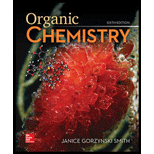
Concept explainers
(a)
Interpretation: The curved arrows are to be used to show the movement of electrons in the given equation.
Concept introduction: There are generally two types of arrows ‘reaction arrows’ and ‘electron arrows’. A reaction arrow gives the information regarding the progress of the reaction. An electronegative element in the reaction attracts electron toward it.
Half headed arrows are used to show the flow of single electrons, while the full headed arrow shows the movement of electron pairs.
(b)
Interpretation: The curved arrows are to be used to show the movement of electrons in the given equation.
Concept introduction: There are generally two types of arrows ‘reaction arrows’ and ‘electron arrows’. A reaction arrow gives the information regarding the progress of the reaction. An electronegative element in the reaction attracts electron toward it.
Half headed arrows are used to show the flow of single electrons, while the full headed arrow shows the movement of electron pairs.
(c)
Interpretation: The curved arrows are to be used to show the movement of electrons in the given equation.
Concept introduction: There are generally two types of arrows ‘reaction arrows’ and ‘electron arrows’. A reaction arrow gives the information regarding the progress of the reaction. An electronegative element in the reaction attracts electron toward it.
Half headed arrows are used to show the flow of single electrons, while the full headed arrow shows the movement of electron pairs.
(d)
Interpretation: The curved arrows are to be used to show the movement of electrons in the given equation.
Concept introduction: There are generally two types of arrows ‘reaction arrows’ and ‘electron arrows’. A reaction arrow gives the information regarding the progress of the reaction. An electronegative element in the reaction attracts electron toward it.
Half headed arrows are used to show the flow of single electrons, while the full headed arrow shows the movement of electron pairs.
Trending nowThis is a popular solution!

Chapter 6 Solutions
Study Guide/solutions Manual For Organic Chemistry
- How does the square root mean square velocity of gas molecules vary with temperature? Illustrate this relationship by plotting the square root mean square velocity of N2 molecules as a function of temperature from T=100 K to T=300 K.arrow_forwardDraw product B, indicating what type of reaction occurs. F3C CF3 NH2 Me O .N. + B OMearrow_forwardBenzimidazole E. State its formula. sState the differences in the formula with other benzimidazoles.arrow_forward
- Draw product A, indicating what type of reaction occurs. F3C CN CF3 K2CO3, DMSO, H₂O2 Aarrow_forward19) Which metal is most commonly used in galvanization to protect steel structures from oxidation? Lead a. b. Tin C. Nickel d. Zinc 20) The following molecule is an example of a: R₁ R2- -N-R3 a. Secondary amine b. Secondary amide c. Tertiary amine d. Tertiary amidearrow_forwardpls helparrow_forward
- pls helparrow_forward35) Complete the following equation by drawing the line the structure of the products that are formed. Please note that in some cases more than one product is possible. You must draw all possible products to recive full marks! a. ethanol + 2-propanol + H2SO4 → b. OH conc. H2SO4 CH2 H3C CH + K2Cr2O7 C. d. H3C A pressure CH3 + H2 CH Pt catalystarrow_forward21) The rate of reaction depends upon: a. the concentration and nature of reactants b. the temperature of the reaction C. whether or not a catalyst was used d. all of the above 22) A Maxwell-Boltzmann curve shows the distribution of molecular energies in a reaction system. When the temperature in this system is increased, the peak is a. higher and further to the right. b. higher and further to the left. c. lower and further to the right. d. lower and further to the left. 23) Which of the following correctly describes the reaction represented by the reaction below? CaCO3 (s) + energy → CaO (s) + CO2 (g) a. It is exothermic and the potential energy is greater in the reactants than the products. b. c. It is exothermic and the potential energy is greater in the products than the reactants. It is endothermic and the potential energy is greater in the products than the reactants. d. It is endothermic and the potential energy is equal for the products and reactants.arrow_forward
 Chemistry for Today: General, Organic, and Bioche...ChemistryISBN:9781305960060Author:Spencer L. Seager, Michael R. Slabaugh, Maren S. HansenPublisher:Cengage Learning
Chemistry for Today: General, Organic, and Bioche...ChemistryISBN:9781305960060Author:Spencer L. Seager, Michael R. Slabaugh, Maren S. HansenPublisher:Cengage Learning Organic ChemistryChemistryISBN:9781305580350Author:William H. Brown, Brent L. Iverson, Eric Anslyn, Christopher S. FootePublisher:Cengage Learning
Organic ChemistryChemistryISBN:9781305580350Author:William H. Brown, Brent L. Iverson, Eric Anslyn, Christopher S. FootePublisher:Cengage Learning Organic Chemistry: A Guided InquiryChemistryISBN:9780618974122Author:Andrei StraumanisPublisher:Cengage Learning
Organic Chemistry: A Guided InquiryChemistryISBN:9780618974122Author:Andrei StraumanisPublisher:Cengage Learning


